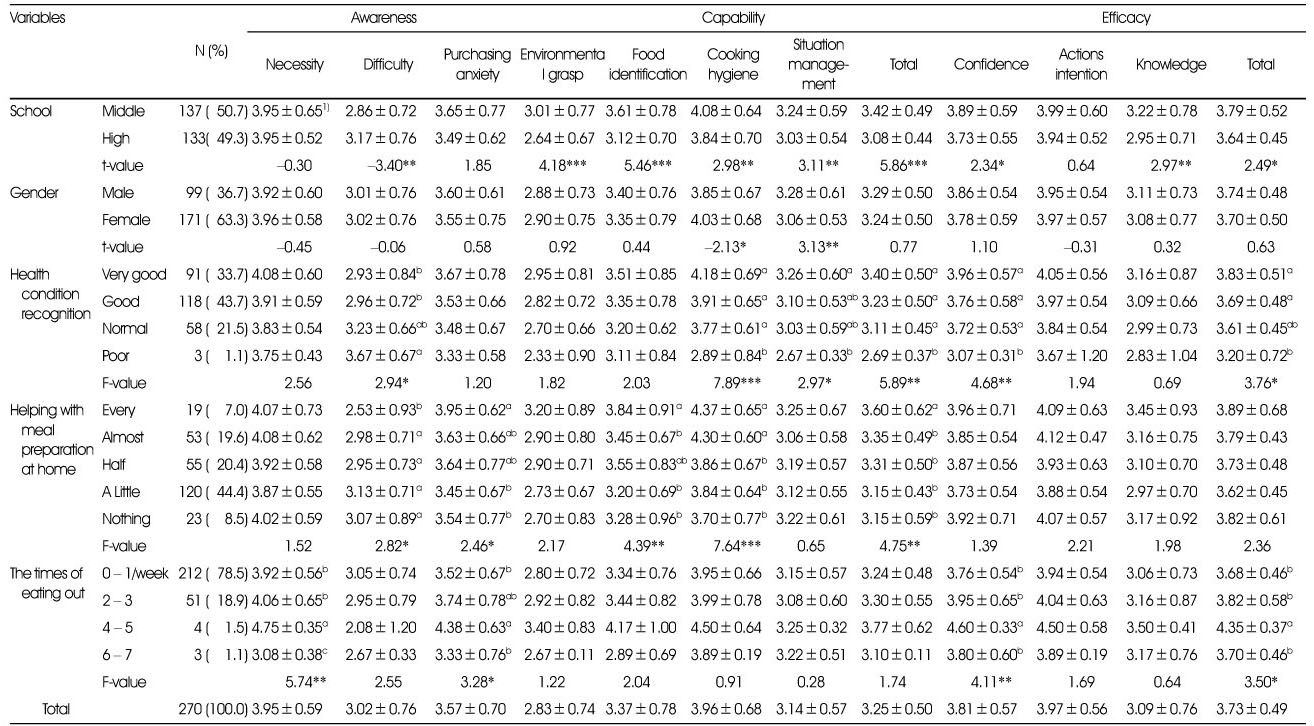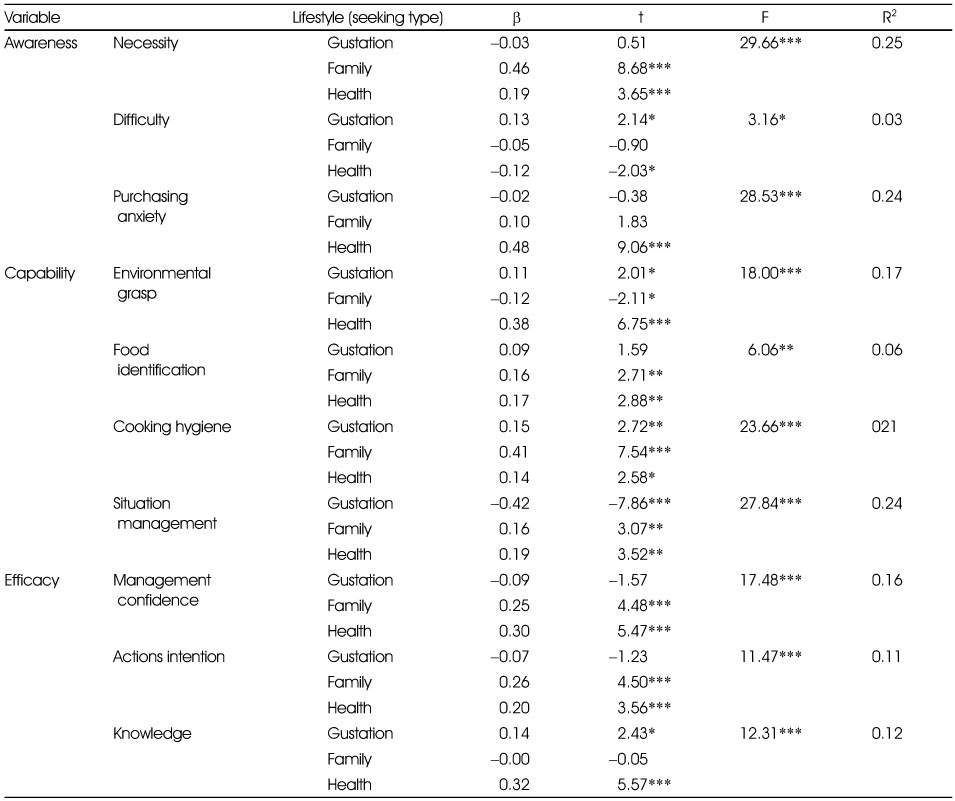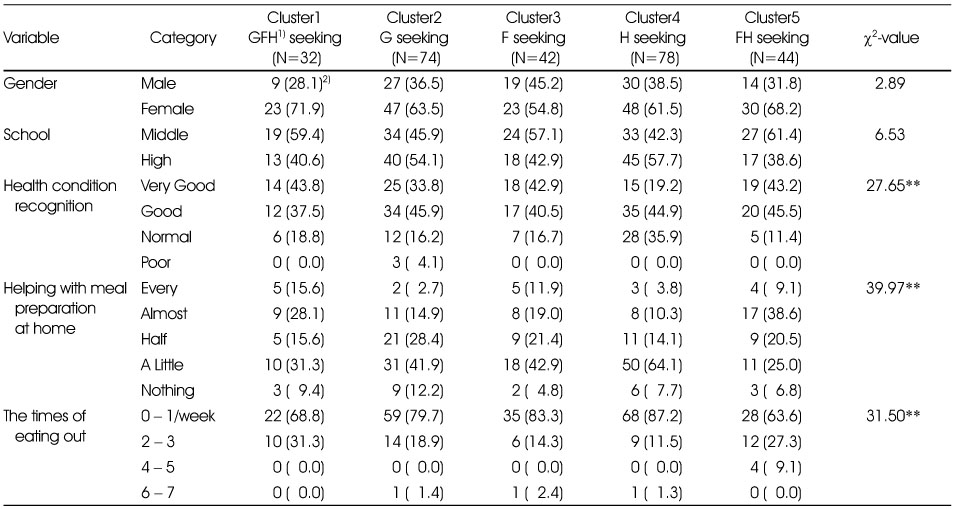References
1. Jeon SK. Educational meanings and effective practical plans of school dietary life education. J Korean Home Econ Educ Assoc 2010;22(1):117–135.
2. Um EK. A study on the segmentation of food related lifestyle within Korean family. J Hotel Resort 2015;14(3):247–265.
3. Engel JF, Blackwell RD. Consumer behavior 9th edth ed. NY: The Dryden Press; 2001.
4. Hong ST, Park EA. Comparison of female consumers' purchasing behavior by lifestyle types: In the case of cosmetics. Korea Mark Rev 2005;20(1):55–89.
5. Grunert KG, Perrea T, Zhou Y, Huang G, Sørensen BT. Is food-related lifestyle (FRL) able to reveal food consumption patterns in non-Western cultural environments? Its adaptation and application in urban China. Appetite 2011;56(2):357–367.
6. Chung W. Achievements and future tasks of the Korean police activities for harmful food elimination. J Korean Public Police Secur Stud 2016;13(1):233–256.
8. Ministry of Government Legislation. Bad food 1st edth ed. Seoul: Humanculturearirang; 2015. p. 1–99.
9. Kim JH. Healthy life education for eradicating harmful food. Proceedings of 2013 Winter Conference of the Home Economics Education Association Gwangju: 2013. Nov. 05. p. 55–75.
10. Kim CK, Yoon BS, Kim HJ. The structure and dynamics of food risk society: Food security and food safe issues revisited. Econ Soc 2012;96:12–42.
11. Kim SU, Kim CK, Lee HJ. Socio-economic differentiation of food anxiety and food consumption behaviors. J Rural Soc 2012;22(1):215–264.
12. Park HS. The structural mechanism of food anxieties/scares and its emotional dynamics. Korean Stud Q 2010;33(2):161–193.
13. Yoo HJ, Joo SH. Development of consumers' perceived food safety and food safety competency measurement. J Consum Stud 2012;23(4):79–104.
14. Choe JS, Chun HK, Hwang DY, Nam HJ. Consumer perceptions of food-related hazards and correlates of degree of concerns about food. J Korean Soc Food Sci Nutr 2005;34(1):66–74.
15. Park NR, Sohn SH. The effects of food safety education on children's food safety knowledge, belief, attitude, and behavior. Consum Policy Educ Rev 2010;6(1):47–66.
16. Lee HS, Hwang SH. An effect of coffee shop customers' foodrelated lifestyle on coffee cocktail menu selection attributes and preference for menus. Tour Res 2014;39(3):141–159.
17. Golmakani N, Naghibi F, Moharari F, Esmaily H. Health promoting life style and its related factors in female adolescents. J Midwifery Reprod Health 2013;1(1):42–49.
18. Spratt J, Shucksmith J, Philip K, Watson C. Part of who we are as a school should include responsibility for well-being: links between the school environment, mental health and behavior. Pastor Care Educ 2006;24(3):14–21.
19. Sung CJ. A comparative study of food habits and body satisfaction of middle school students according to clinical symptoms. J Korean Soc Food Sci Nutr 2005;34(2):202–208.
20. Lee JS, Yun JW. A study on perception about body image, dietary attitude, dietary self-efficacy and nutrient intake of high school students in Busan. J Korean Soc Food Sci Nutr 2003;32(2):295–301.
21. Woo T, Lee HJ, Lee KA, Lee SM, Lee KH. Gender differences in adolescents' dietary perceptions and practices. Korean J Community Nutr 2016;21(2):165–177.
22. Yoo SJ, Jung LH. A study on food involvement and dietary behavior of middle school students in Naju area. J Home Econ Educ Assoc 2008;20(1):63–83.
23. Grunert KG, Brunso K, Bisp S. Food-related life style: development of a cross-culturally valid instrument for market surveillance. MAPP working paper 1993. p. 12.
24. Yim YM, Yoon HH. A study on the food-related life style to wine selection attribution. Korea Tour Res Assoc 2006;20(3):289–300.
25. Oh SC, Jang JS. The effects of food-related lifestyle on carbonated beverage consumption behavior of the middle school students. Korean J Food Nutr 2014;27(6):1043–1050.
26. Oh SC, Jang JS. The relationship of food-related lifestyle type and fast food consumption behaviors of the middle school students. Korean J Food Nutr 2015;28(1):119–125.
27. Jung YH, Kim HI, In KS. The impact of food consumption lifestyle on the comfort food and customer satisfaction. J Hotel Resort 2014;13(2):163–182.
28. Choi W, Choi JY, Yon HS. A study on purchasing characteristics on health functional beverage according to food-related lifestyle. J Hotel Resort 2013;12(1):179–196.
29. Kim HC, Kim MR. Intake behavior regarding beverages according to dietary lifestyles of university students. J East Asian Soc Dietary Life 2015;25(2):223–233.
30. Kim CK. The modern food system and food sovereignty. ECO 2008;12(2):7–32.





